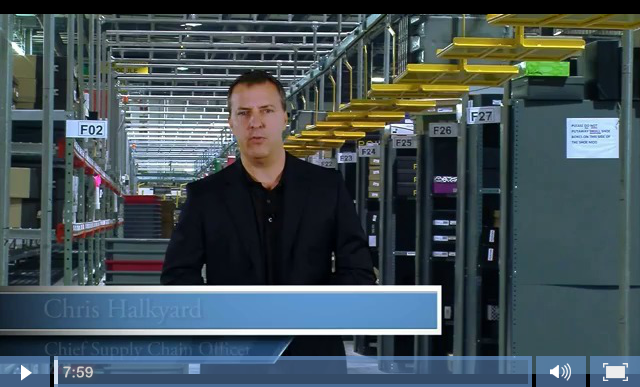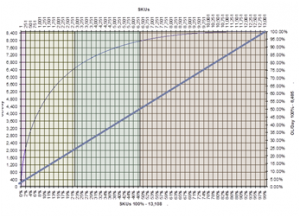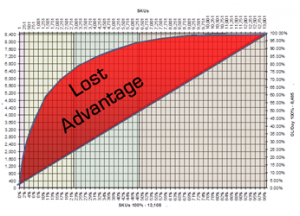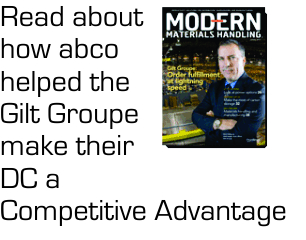The Distribution Center as a Competitive Advantage: Gilt Groupe
Read the transcript of “The Distribution Center as a Competitive Advantage: Gilt Groupe”.
So what we have is an engine for production. We can get everything stored properly here and it makes order picking efficient and very cost-effective.
Gilt Groupe is a private sale, flash sales company founded back in 2007. We buy luxury items and sell them on a first-come first-served basis, so it creates a competitive shopping environment. The real challenge is the supply chain and logistics strategy on how we continue to scale that business and create a customer service environment that continues to stay best in the industry, so that customers are getting their product on time and in great condition.
We chose to work with abco automation, because instead of them coming in and saying, “what you should do is..” they asked us a lot of questions about our business model instead of just trying to sell us something. Which is really, really important and selling us what we needed instead of what they wanted to sell us. That was the really big difference between abco automation and some of the other players that were out their looking to get our business.
Jack Lehr: When we are called in to look at a distribution center or supply chain we just don’t starting throwing ideas at the customer. We want to find out as much as we can about their current operation, their business model; we want to get a good look at the data from their operation. Without a good grasp on the data I am not sure how you can design a solution that works for the client.
We do the Math that’s abco’s mantra.
Let’s take a tour of the distribution center and show you how all this works together to give Gilt Groupe the throughput and accuracy that they need to guarantee their exceptional customer service.
Gilt is primarily an apparel company so they have a very large receiving area. Associates place all non-GOH garments, flatpack, home goods, jewelry and shoes on gravity lines so an entire order is accumulated. Once a shipment is accumulated they verify it versus the P.O. and ensure that it is presentable for sale.
Then an associate transports it via a cart to a second set of lines, the sort area. This is where all the products are sorted into like, sellable units, placed in totes on the conveyor going to put-away. Every tote has a barcode and an ID so every SKU is active in the system down to the each level.
Part of ensuring great customer service is inventory accuracy. If you say you have something available for sale, you must be positive; and this system allows that certainty.
When the associate scans the item directly into the W.M.S. in receiving, the systems makes real-time decisions about where to send the product. It can go to one of six areas in the distribution center.
Bulk hold.
The Product-to-person area,
The GOH area,
The Pick Module,
Shoe storage,
Jewelry,
The path the product takes depends on how fast the item will be sold. One of the main benefits of this DC is that all the items are not treated the same. The system handles items differently based on product volume-etric characteristics. We know that not every item will move through the distribution center at the same rate. So we designed storage and picking to address the Pareto curve of individual items.
This is the bulk hold area and it performs two functions. It allows Gilt’s buyers the ability to buy large quantities of items that are not ready to be sold immediately. In addition, while Gilt is known primarily for apparel they also sell home goods and larger items that are not conveyable that can be stored and picked here.
Fast-moving items that will sell immediately go to the product-to-person system. Associates remove product from the totes and place it on one of the mobile shelves. While some items can go directly on the shelves other SKUs are placed in the smaller shelf bins if there is danger that they might fall while the robot is in motion.
There are approximately 50,000 storage locations in this area. Product-to-person is important in the Gilt distribution center because it eliminates the need for pickers to continually go to the same area to pick a fast-moving product. The product-to-person area enables Gilt to achieve an enviable amount of picks-per-minute and to support the fast-moving e-commerce business model.
The pick model is the medium to slow moving product storage area and has three levels.
Gilt stores its garment-on-hanger items on the first floor of the pick module. The G.O.H. area can accommodate approximately 50,000 pieces of product for Gilt.
The second and third levels are for “B” movers, the products that don’t move as fast as the ones in the product-to-person picking area. In addition this is where Gilt can store any remnant items from previous flash sales.
In front of the product-to-person area is the shoe storage area for the distribution center. Shoes are a very specific business for Gilt so we built a very specific storage and picking area for shoes. The shoe boxes fit perfectly in the storage area minimizing the space needed.
Gilt recently transitioned its jewelry business from their Brooklyn distribution center to Kentucky. Jewelry requires higher levels of accuracy and security and we adapted that to the Gilt process. By designing a secured area to receive, stock, pick and pack jewelry the DC handles the distribution of fine clothing alongside the distribution of fine jewelry.
When picking starts, the order tote can start in any area. This greatly increases efficiency, because a typical order only contains one or two different products. In addition if an item is not needed from a particular part of the DC the order tote bypasses that area.
The path for the order totes goes from the jewelry area, to shoes and then onto the product-to-person area. Then it continues to the GOH area on the first floor of the pick module, then to one of the upper-level picking areas, where there are 24 pick-zones.
After the order is picked it goes to the shipping area.
One area that we looked at very closely was the packing portion of it, as well as the manifesting. We decided to go a different way and the way that abco built this, is we separated the process.
Packing is a customer service function. And that’s where we ensure the order that our customer receives meets or exceeds their expectations.
It then goes over to another area unsealed, the Manifesting area which deals with the physical logistics of shipping. We weight it, we put the label on it, but we also have additional quality function there which allows the person shipping it out to verify that the correct contents are in the box. This leads to exceptional customer service.
The way this building was designed we can bring a multitude of merchandise in here at any given time and be able to scale it in the way we need to do it.
So what we have here is an engine for production we get everything stored properly here and it makes order picking efficient and very cost-effective.
This is the distribution system that abco automation designed and built for Gilt Groupe, so that even with their explosive growth they still maintain their high level of customer service and accuracy.




